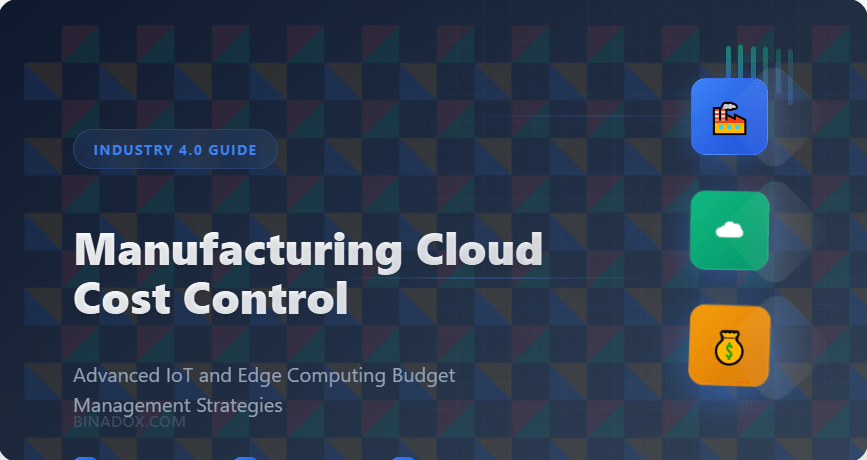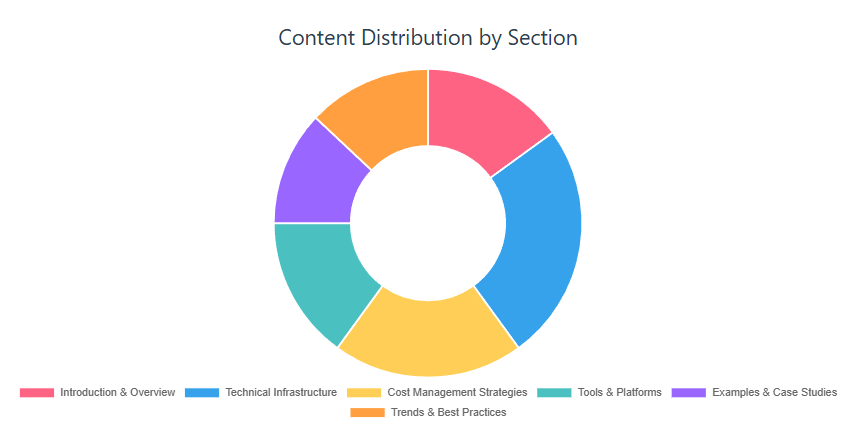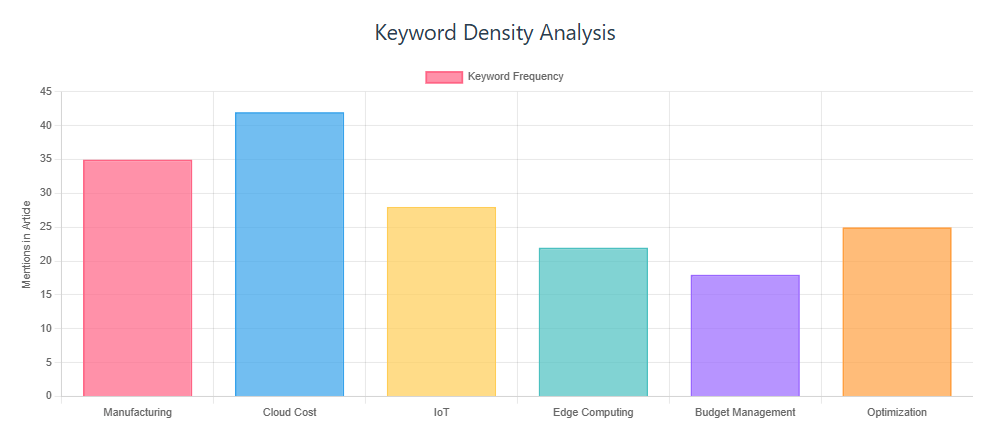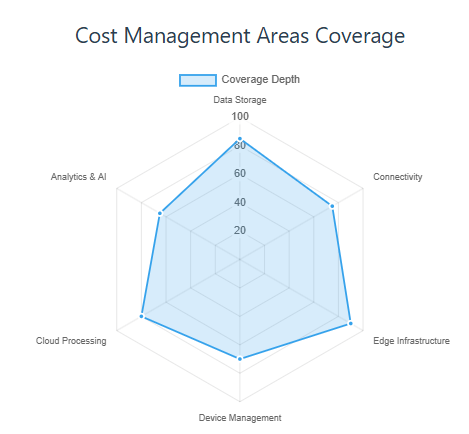
Introduction to Manufacturing Cloud Cost Control
The manufacturing industry is experiencing a digital transformation revolution, with cloud computing, Internet of Things (IoT), and edge computing technologies becoming integral to modern industrial operations. As manufacturers increasingly adopt these technologies to enhance efficiency, improve quality, and maintain competitive advantage, managing the associated cloud costs has become a critical business challenge.
Manufacturing companies typically deploy complex technology ecosystems that include industrial IoT sensors, edge computing devices, cloud-based analytics platforms, and automated control systems. While these technologies offer significant operational benefits, they can also generate substantial and unpredictable cloud expenses if not properly managed. Effective cloud cost management requires a strategic approach that balances technological innovation with financial discipline.
This comprehensive guide addresses the unique challenges manufacturing organizations face in controlling cloud costs while leveraging IoT and edge computing technologies. Unlike traditional IT environments, manufacturing systems often operate in harsh industrial conditions, require real-time processing capabilities, and must maintain high availability to avoid costly production downtime.
The complexity of manufacturing cloud cost control stems from several factors: the distributed nature of industrial IoT deployments, the varying computational requirements of edge devices, the need for reliable connectivity across factory floors, and the integration requirements with existing industrial systems. Additionally, manufacturing companies must consider regulatory compliance, safety requirements, and the need for predictable operational expenses in their cost management strategies.
By implementing proper cost control measures, manufacturers can achieve significant savings while maintaining operational excellence. Studies show that organizations with effective cloud financial management practices can reduce their cloud spending by 20-30% without compromising performance or reliability.

Understanding Manufacturing Cloud Infrastructure
Manufacturing cloud infrastructure differs significantly from traditional enterprise IT systems due to its operational requirements, regulatory constraints, and integration complexity. Modern manufacturing environments typically employ a hybrid approach that combines on-premises systems, edge computing resources, and cloud-based services to create comprehensive industrial automation solutions.
Industrial IoT Architecture
The foundation of modern manufacturing cloud infrastructure is built on Industrial Internet of Things (IIoT) systems that collect data from sensors, machines, and production lines. These systems generate massive amounts of data that must be processed, analyzed, and stored efficiently. The typical IIoT architecture includes:
- Sensor networks collecting real-time operational data
- Edge gateways processing local data and filtering information
- Cloud platforms for advanced analytics and machine learning
- Enterprise systems integration for business intelligence
- Mobile and web applications for monitoring and control
Edge Computing Integration
Edge computing plays a crucial role in manufacturing environments by providing low-latency processing capabilities near the point of data generation. This approach reduces bandwidth costs, improves response times, and enables real-time decision-making. However, edge computing also introduces additional cost considerations including hardware investments, maintenance requirements, and distributed management complexity.
Hybrid Cloud Considerations
Many manufacturers opt for hybrid cloud architectures that allow them to maintain sensitive data on-premises while leveraging cloud scalability for analytics and non-critical workloads. This approach provides flexibility but requires careful cost management across multiple environments.
The complexity of manufacturing cloud infrastructure requires specialized cloud management strategies that account for industrial-specific requirements such as deterministic performance, safety certifications, and integration with legacy systems.
IoT Cost Management in Manufacturing
Internet of Things deployments in manufacturing environments present unique cost management challenges due to their scale, diversity, and operational requirements. Understanding and controlling these costs is essential for maintaining profitable operations while realizing the benefits of industrial digitization.
Data Generation and Storage Costs
Manufacturing IoT systems typically generate enormous volumes of data from sensors monitoring temperature, pressure, vibration, energy consumption, and production metrics. A single manufacturing facility can have thousands of sensors generating data continuously, resulting in terabytes of information daily. This data generation directly impacts cloud storage and processing costs.
Effective IoT cost management requires implementing data tiering strategies that distinguish between critical real-time data requiring immediate processing and historical data suitable for cold storage. Manufacturers should also consider data retention policies that automatically archive or delete obsolete information to minimize storage expenses.
Connectivity and Bandwidth Optimization
IoT devices require reliable connectivity to transmit data to cloud platforms, but bandwidth costs can escalate quickly without proper management. Manufacturers can optimize connectivity costs through several approaches:
- Implementing edge processing to reduce data transmission volumes
- Using data compression and aggregation techniques
- Selecting appropriate connectivity options (WiFi, cellular, LoRaWAN) based on use case requirements
- Negotiating volume discounts with connectivity providers
Device Management and Lifecycle Costs
Managing large fleets of IoT devices involves ongoing costs for firmware updates, security patches, monitoring, and eventual replacement. Manufacturers should implement centralized device management platforms that can efficiently handle these operations at scale while minimizing manual intervention.
The scalability of cloud computing enables manufacturers to start with small IoT deployments and expand gradually, but this requires careful planning to avoid cost escalation as the system grows.
Edge Computing Budget Considerations
Edge computing has become increasingly important in manufacturing environments, enabling real-time processing, reducing latency, and improving operational efficiency. However, edge computing deployments require careful budget planning to ensure cost-effectiveness while meeting performance requirements.
Infrastructure Investment Planning
Edge computing requires upfront investments in hardware, software, and networking infrastructure. Manufacturers must balance the costs of edge hardware against the benefits of reduced cloud processing expenses and improved performance. Key considerations include:
- Edge server hardware costs and specifications
- Networking infrastructure requirements
- Software licensing for edge platforms
- Environmental controls and physical security
- Backup power and redundancy systems
Operational and Maintenance Expenses
Unlike centralized cloud resources, edge computing infrastructure requires ongoing maintenance, updates, and support at distributed locations. This creates additional operational expenses that must be factored into budget planning:
- On-site technical support and maintenance
- Regular hardware refresh cycles
- Software updates and security patches
- Energy consumption and cooling costs
- Physical security and access control
Hybrid Processing Cost Optimization
Effective edge computing strategies involve determining the optimal balance between edge and cloud processing to minimize total costs while meeting performance requirements. Manufacturers should analyze their workloads to identify which processes benefit from edge computing and which are more cost-effective in the cloud.
The integration of edge computing with existing manufacturing systems may require additional investments in automation tools and integration platforms to ensure seamless operation and data flow.
Current State of Manufacturing Cloud Adoption
The manufacturing industry has been experiencing rapid cloud adoption, driven by digital transformation initiatives, Industry 4.0 concepts, and the need for operational agility. Understanding current market trends helps manufacturers benchmark their cloud investments and identify cost optimization opportunities.
Market Growth and Investment Trends
According to industry research, the global manufacturing cloud market is expected to grow significantly over the next five years, with investments in IoT, artificial intelligence, and edge computing leading the expansion. This growth is driven by manufacturers’ need to improve operational efficiency, reduce downtime, and enhance product quality through data-driven insights.
Manufacturing companies are increasingly investing in cloud-based solutions for:
- Predictive maintenance and asset optimization
- Supply chain visibility and optimization
- Quality management and defect reduction
- Energy management and sustainability initiatives
- Worker safety and environmental monitoring
Sector-Specific Adoption Patterns
Different manufacturing sectors exhibit varying cloud adoption patterns based on their operational requirements, regulatory constraints, and competitive pressures:
Automotive Manufacturing: Leading in IoT and edge computing adoption for production line optimization, quality control, and supply chain management.
Aerospace and Defense: Focused on secure cloud solutions that meet stringent regulatory requirements while enabling advanced analytics.
Food and Beverage: Emphasizing traceability, safety monitoring, and regulatory compliance through cloud-based systems.
Pharmaceuticals: Investing heavily in cloud platforms for research and development, clinical trials, and manufacturing compliance.
Electronics: Leveraging cloud technologies for rapid product development, testing, and market responsiveness.
Regional Differences
Cloud adoption in manufacturing varies significantly by region, with developed markets leading in advanced analytics and AI applications, while emerging markets focus on basic digitization and connectivity improvements. These differences create opportunities for technology providers and influence global cloud computing pricing models.

Cost Optimization Strategies for Industrial IoT
Implementing effective cost optimization strategies for industrial IoT systems requires a comprehensive understanding of technology options, operational requirements, and financial constraints. Successful manufacturers employ multiple approaches to control costs while maximizing the value of their IoT investments.
Data Architecture Optimization
One of the most effective ways to control IoT costs is through intelligent data architecture design that minimizes unnecessary data transmission and storage. Key strategies include:
Edge Processing Implementation: Processing data locally at edge devices reduces bandwidth consumption and cloud processing costs. Manufacturers can implement edge analytics to filter, aggregate, and analyze data before transmission, sending only relevant insights to cloud platforms.
Data Tiering Strategies: Implementing automated data tiering moves frequently accessed data to high-performance storage while archiving historical data to lower-cost storage options. This approach can reduce storage costs by 60-80% for large manufacturing datasets.
Compression and Deduplication: Advanced data compression techniques and deduplication algorithms can significantly reduce storage and transmission costs without compromising data quality or accessibility.
Resource Right-Sizing and Optimization
Manufacturing IoT deployments often begin with oversized resources to ensure adequate performance, but this approach can lead to significant cost waste. Rightsizing cloud resources involves continuously monitoring and adjusting resource allocation to match actual usage patterns.
Effective rightsizing strategies include:
- Regular analysis of compute resource utilization
- Automated scaling based on production schedules
- Seasonal adjustment for varying production demands
- Performance monitoring to identify optimization opportunities
Network and Connectivity Optimization
Connectivity costs can represent a significant portion of IoT operational expenses, particularly for deployments with hundreds or thousands of connected devices. Manufacturers can optimize these costs through:
- Multi-carrier connectivity strategies for redundancy and cost optimization
- Edge gateway consolidation to reduce individual device connectivity requirements
- Bandwidth optimization through intelligent data routing and caching
- Negotiated volume pricing with connectivity providers
Vendor and Platform Consolidation
Managing multiple IoT platforms and vendors can create administrative overhead and increase costs. Consolidating IoT solutions onto fewer platforms can provide economies of scale, simplified management, and better negotiating power with vendors.
The implementation of comprehensive SaaS spend management practices helps manufacturers track and optimize costs across their various IoT and cloud platforms.

Budget Management Tools and Platforms
Effective manufacturing cloud cost control requires sophisticated budget management tools that can handle the complexity of industrial IoT deployments, edge computing resources, and multi-vendor environments. These tools provide visibility, control, and optimization capabilities essential for maintaining cost discipline.
Cloud Cost Management Platforms
Modern cloud cost management tools provide comprehensive visibility into manufacturing cloud expenses across multiple providers and services. Key features include:
Multi-Cloud Support: Manufacturing environments often utilize multiple cloud providers for different purposes, requiring tools that can aggregate costs and provide unified reporting across AWS, Microsoft Azure, Google Cloud Platform, and other providers.
Real-Time Monitoring: Manufacturing operations require immediate visibility into cost anomalies that could indicate system failures, security breaches, or operational inefficiencies. Real-time monitoring capabilities enable quick response to unexpected cost spikes.
Automated Alerting: Proactive cost management requires automated alerts when spending exceeds predefined thresholds or unusual patterns are detected. These alerts enable manufacturing teams to address issues before they become significant financial problems.
Resource Tagging and Attribution
Proper resource tagging is essential for manufacturing cost management, enabling organizations to attribute costs to specific production lines, facilities, or business units. Effective cloud tagging strategies should include:
- Production line identification
- Facility and location tags
- Business unit and cost center attribution
- Project and initiative tracking
- Environment classification (production, testing, development)
Budgeting and Forecasting Capabilities
Manufacturing organizations need robust budgeting and forecasting tools that can account for production seasonality, capacity changes, and technology evolution. Advanced platforms provide:
- Predictive cost modeling based on historical data
- Scenario planning for capacity changes
- Budget variance reporting and analysis
- Cost allocation and chargeback capabilities
Integration with Manufacturing Systems
The most effective cost management tools integrate with existing manufacturing systems such as Enterprise Resource Planning (ERP), Manufacturing Execution Systems (MES), and Computerized Maintenance Management Systems (CMMS). This integration enables correlation between production activities and cloud costs, providing insights into operational efficiency and cost optimization opportunities.
Automated Cost Optimization
Advanced platforms provide automated cost optimization capabilities that can identify and implement cost-saving measures without manual intervention. These features include:
- Automatic resource scheduling based on production schedules
- Idle resource identification and shutdown
- Reserved instance recommendations and purchases
- Storage optimization and archiving
Implementing comprehensive cost anomaly detection helps manufacturing organizations identify and address cost issues before they impact profitability.
Real-World Examples of Manufacturing Cost Control
Understanding how other manufacturing organizations have successfully implemented cloud cost control provides valuable insights and best practices that can be adapted to different industrial environments.
Good Manufacturing Cloud Cost Practices
Automotive Manufacturer Case Study: A major automotive manufacturer implemented a comprehensive IoT cost management strategy that reduced cloud expenses by 35% while improving production efficiency. Key practices included:
- Centralized IoT platform management across all facilities
- Edge processing implementation to reduce data transmission costs by 60%
- Automated resource scaling based on production schedules
- Comprehensive cost allocation to individual production lines
- Regular vendor negotiations and contract optimization
Electronics Manufacturer Success Story: A global electronics manufacturer achieved significant cost savings through intelligent data management and edge computing optimization:
- Implementation of tiered data storage reducing storage costs by 70%
- Edge analytics deployment eliminating 80% of unnecessary data transmission
- Automated quality control systems reducing inspection costs by 45%
- Consolidated vendor management reducing administrative overhead by 25%
Food Processing Cost Optimization: A large food processing company demonstrated effective cost control through strategic technology deployment:
- IoT sensor optimization reducing device count by 40% while maintaining monitoring coverage
- Energy management systems achieving 20% reduction in facility energy costs
- Predictive maintenance implementation reducing equipment downtime by 50%
- Supply chain optimization through cloud-based logistics management
Poor Manufacturing Cloud Cost Practices
Uncontrolled IoT Device Proliferation: A manufacturing company experienced cost overruns due to unmanaged IoT device deployment, resulting in:
- Redundant sensor installations creating unnecessary costs
- Lack of device lifecycle management leading to obsolete hardware
- Unoptimized data collection generating excessive cloud storage expenses
- Poor vendor coordination resulting in contract inefficiencies
Inadequate Edge Computing Planning: Another manufacturer faced budget challenges due to insufficient edge computing planning:
- Over-investment in edge hardware for minimal performance benefits
- Lack of integration between edge and cloud systems
- Inadequate maintenance planning for distributed edge infrastructure
- Poor cost attribution preventing optimization efforts
Lack of Cost Visibility: A manufacturing organization struggled with cost control due to insufficient monitoring and reporting:
- No cost allocation to specific production activities
- Limited visibility into cloud resource utilization
- Reactive rather than proactive cost management
- Absence of automated cost optimization measures
These examples demonstrate the importance of implementing comprehensive FinOps practices and maintaining disciplined cost management approaches throughout the organization.
Emerging Trends in Manufacturing Cloud Economics
The manufacturing industry continues to evolve rapidly, with new technologies and business models creating both opportunities and challenges for cloud cost management. Understanding emerging trends helps manufacturers prepare for future cost implications and optimization opportunities.
Artificial Intelligence and Machine Learning Integration
AI and ML technologies are becoming increasingly important in manufacturing applications, from predictive maintenance to quality control and supply chain optimization. However, these technologies can significantly impact cloud costs due to their computational requirements:
- Training AI models requires substantial computing resources and can generate significant costs
- Real-time AI inference at edge locations requires investment in specialized hardware
- Data storage and management for AI applications can scale rapidly
- Integration with existing systems may require additional cloud services and connectivity
Manufacturers are addressing these challenges through strategic AI deployment, focusing on high-value use cases and implementing cost-effective inference architectures that balance performance with expenses.
5G and Advanced Connectivity
The deployment of 5G networks and other advanced connectivity technologies is transforming manufacturing IoT capabilities, enabling new applications such as augmented reality, remote control, and ultra-low latency automation. These advancements create new cost considerations:
- Higher bandwidth capabilities may increase data transmission volumes and costs
- Advanced applications may require more sophisticated edge computing infrastructure
- Network slicing and quality of service features may command premium pricing
- Integration with existing connectivity infrastructure may require additional investments
Sustainability and Green Computing
Environmental sustainability is becoming increasingly important for manufacturing organizations, influencing cloud cost management strategies through:
- Selection of cloud providers with renewable energy commitments
- Implementation of energy-efficient computing architectures
- Optimization of resource utilization to minimize environmental impact
- Integration with carbon accounting and sustainability reporting systems
Industry 4.0 and Digital Twin Technologies
The continued evolution of Industry 4.0 concepts and digital twin technologies is creating new cloud cost implications:
- Digital twin models require substantial computational resources for simulation and analysis
- Real-time synchronization between physical and digital systems increases data processing requirements
- Advanced simulation capabilities may require specialized cloud services and computing resources
- Integration across multiple systems and vendors can create complex cost attribution challenges
Understanding these trends and their cost implications enables manufacturers to plan effectively for future technology investments and maintain cost discipline while pursuing innovation opportunities.
Best Practices for Manufacturing Cloud Cost Control
Implementing effective cloud cost control in manufacturing environments requires a comprehensive approach that addresses technology, processes, and organizational factors. The following best practices provide a framework for achieving cost optimization while maintaining operational excellence.
Establish Comprehensive Cost Governance
Effective cost governance provides the foundation for successful cloud cost management in manufacturing organizations:
Cost Center Accountability: Assign clear responsibility for cloud costs to specific business units, production lines, or projects. This accountability ensures that cost management becomes an integral part of operational decision-making rather than an afterthought.
Regular Cost Reviews: Implement regular cost review processes that analyze spending patterns, identify optimization opportunities, and ensure alignment with business objectives. These reviews should include representation from IT, operations, finance, and business stakeholders.
Budget Planning and Forecasting: Develop comprehensive budget planning processes that account for production seasonality, capacity changes, and technology evolution. Include contingency planning for unexpected cost variations or operational changes.
Implement Automated Cost Controls
Automation is essential for managing the complexity and scale of manufacturing cloud environments:
Automated Resource Scheduling: Implement automated systems that scale cloud resources based on production schedules, reducing costs during non-production periods while ensuring adequate capacity during peak operations.
Cost Alerting and Anomaly Detection: Deploy automated systems that detect unusual cost patterns and alert appropriate personnel before issues become significant financial problems.
Policy Enforcement: Implement automated policy enforcement that prevents unauthorized resource deployments, ensures proper tagging, and maintains compliance with cost management guidelines.
Optimize Data Management Strategies
Data represents one of the largest cost components in manufacturing IoT deployments:
Intelligent Data Retention: Implement policies that automatically archive or delete data based on business value, regulatory requirements, and operational needs.
Tiered Storage Strategies: Use automated data tiering to move data between different storage classes based on access patterns and cost considerations.
Compression and Optimization: Deploy data compression and optimization technologies to reduce storage and transmission costs without compromising data quality.
Vendor Management and Procurement
Effective vendor management can significantly impact cloud costs:
Consolidated Procurement: Leverage volume discounts through consolidated procurement across multiple facilities and business units.
Regular Contract Reviews: Conduct regular reviews of cloud service contracts to ensure pricing remains competitive and services align with current needs.
Multi-Vendor Strategies: Maintain relationships with multiple vendors to ensure competitive pricing and avoid vendor lock-in situations.
Performance Monitoring and Optimization
Continuous monitoring and optimization ensure that cloud investments deliver maximum value:
Resource Utilization Analysis: Regularly analyze resource utilization to identify opportunities for rightsizing or elimination of unnecessary resources.
Performance Benchmarking: Establish performance benchmarks that balance cost and operational requirements, ensuring that cost optimization efforts don’t compromise operational excellence.
Continuous Improvement: Implement continuous improvement processes that regularly evaluate and update cost management strategies based on changing business requirements and technology capabilities.
The implementation of these best practices requires commitment from leadership and collaboration across organizational boundaries. Organizations that successfully implement comprehensive cost management practices typically achieve 20-30% cost reductions while improving operational efficiency and agility.
How Binadox Supports Manufacturing Cost Management
Manufacturing organizations require specialized cloud cost management solutions that understand the unique requirements of industrial environments, IoT deployments, and edge computing architectures. Binadox provides comprehensive cost management capabilities specifically designed to address these manufacturing challenges.
Multi-Cloud Manufacturing Visibility
Binadox offers centralized visibility across all cloud providers and services used in manufacturing environments. This comprehensive view enables organizations to:
- Monitor costs across AWS, Microsoft Azure, Google Cloud Platform, and other cloud providers
- Track expenses for IoT platforms, edge computing resources, and industrial applications
- Correlate costs with production activities and operational metrics
- Identify optimization opportunities across the entire technology stack
Industrial IoT Cost Optimization
The platform provides specialized features for managing IoT-related costs in manufacturing environments:
- Device-level cost tracking and attribution
- Data transmission and storage optimization recommendations
- Edge computing resource management and optimization
- Automated scaling based on production schedules and operational requirements
Advanced Analytics and Reporting
Binadox delivers sophisticated analytics capabilities that help manufacturing organizations understand and optimize their cloud investments:
- Cost allocation to specific production lines, facilities, and business units
- Trend analysis and forecasting for budget planning
- Anomaly detection for proactive cost management
- Performance correlation between cloud costs and operational metrics
Automated Cost Management
The platform provides automation capabilities that reduce administrative overhead while ensuring cost discipline:
- Automated resource scheduling and scaling
- Policy enforcement for cost management compliance
- Proactive alerting for cost anomalies and budget variances
- Intelligent recommendations for cost optimization
Integration with Manufacturing Systems
Binadox integrates with existing manufacturing systems to provide comprehensive cost visibility and management:
- ERP system integration for financial reporting and cost allocation
- MES integration for correlation with production activities
- CMMS integration for maintenance cost tracking
- Custom API integration for specialized manufacturing applications
Compliance and Security
Manufacturing organizations have specific compliance and security requirements that Binadox addresses through:
- Regulatory compliance support for manufacturing standards
- Secure data handling and access controls
- Audit trails and documentation for financial compliance
- Integration with existing security and governance frameworks
For manufacturing organizations looking to optimize their cloud costs while maintaining operational excellence, Binadox provides the specialized capabilities and industry expertise needed to achieve significant cost savings and improved financial transparency.
Conclusion
Manufacturing cloud cost control represents a critical capability for organizations seeking to leverage IoT and edge computing technologies while maintaining financial discipline and operational efficiency. The unique requirements of manufacturing environments – including real-time processing needs, distributed deployments, and integration with existing industrial systems – create both opportunities and challenges for cost optimization.
Successful manufacturing cloud cost management requires a comprehensive approach that addresses technology architecture, operational processes, and organizational governance. Organizations that implement effective cost control practices typically achieve significant savings while improving operational agility and competitive advantage.
The key to success lies in balancing the benefits of advanced technologies with disciplined cost management practices. This includes implementing intelligent data management strategies, optimizing edge computing deployments, leveraging automation for cost control, and maintaining visibility across complex multi-vendor environments.
As manufacturing technology continues to evolve with AI integration, 5G connectivity, and advanced automation capabilities, effective cost management becomes increasingly important for maintaining competitiveness and profitability. Organizations that establish strong cost management foundations today will be better positioned to adapt to future technology changes while controlling expenses.
The investment in proper cloud cost management tools and practices pays dividends through improved financial visibility, reduced operational expenses, and enhanced ability to make data-driven decisions about technology investments. For manufacturing organizations, this capability represents not just a cost-saving opportunity, but a strategic advantage in an increasingly competitive global marketplace.
By implementing the strategies, tools, and best practices outlined in this guide, manufacturing organizations can achieve optimal balance between technological innovation and financial responsibility, ensuring that their cloud investments deliver maximum value while supporting long-term business success.

